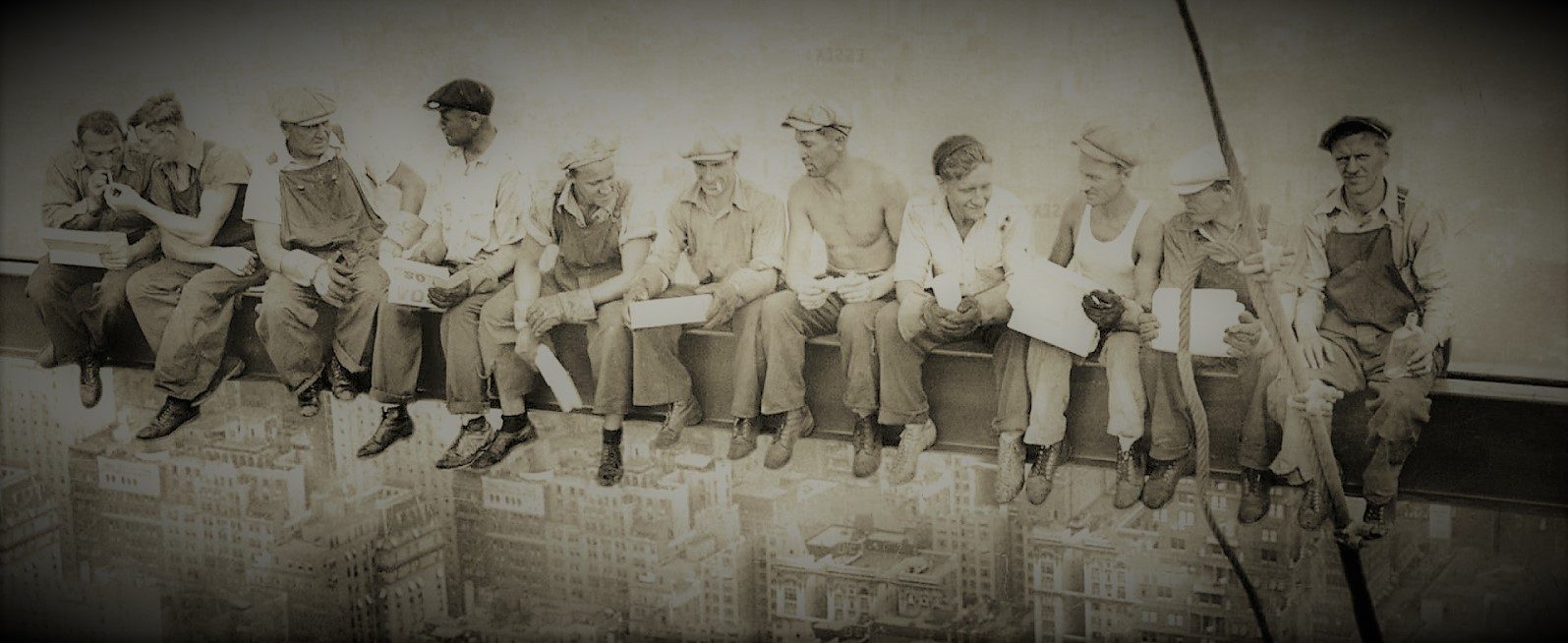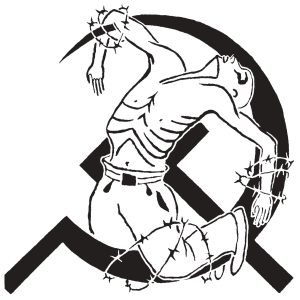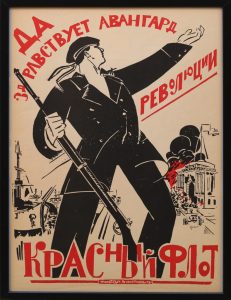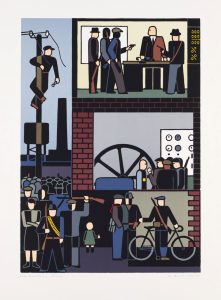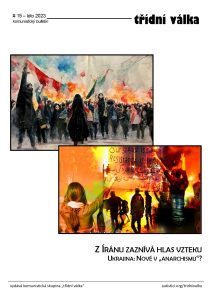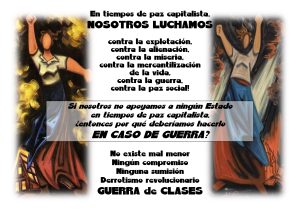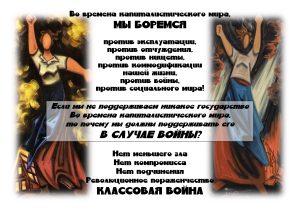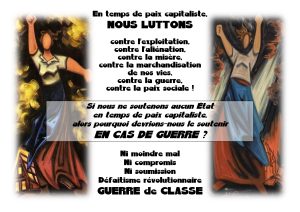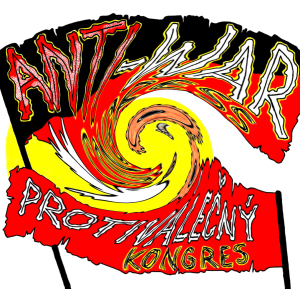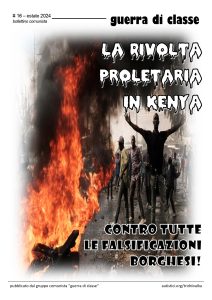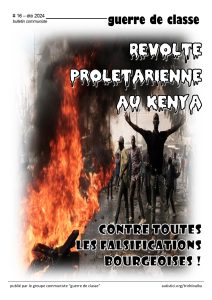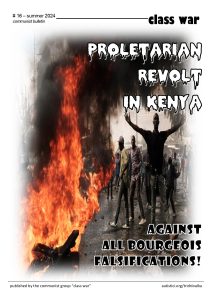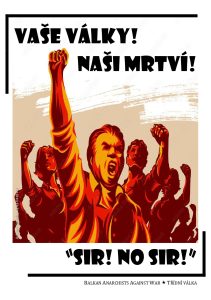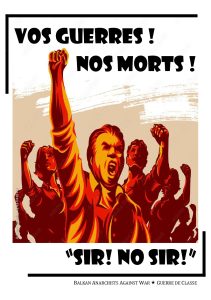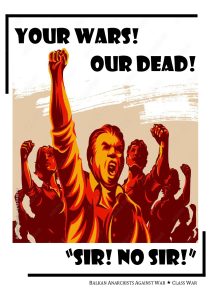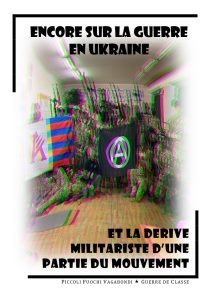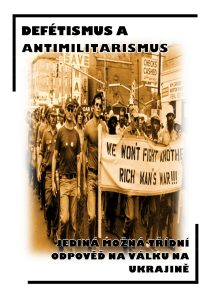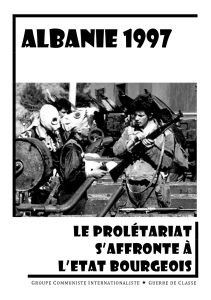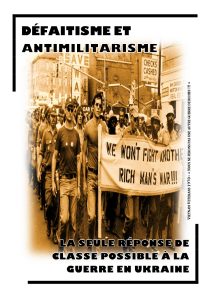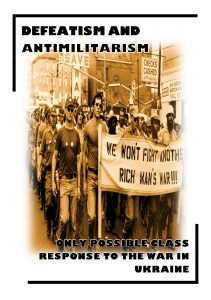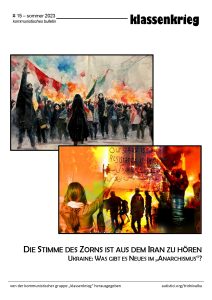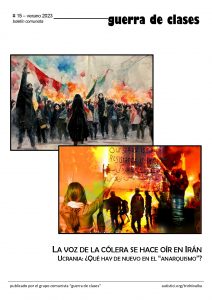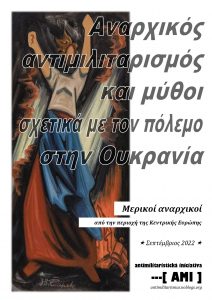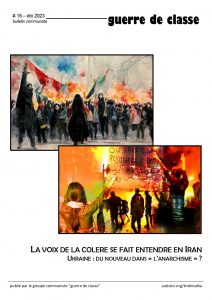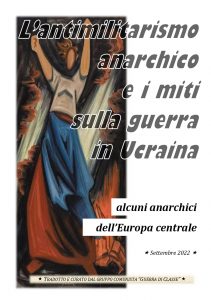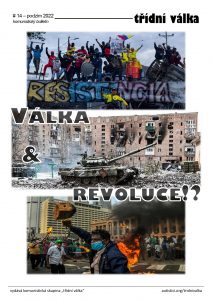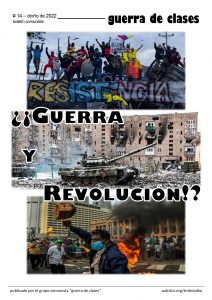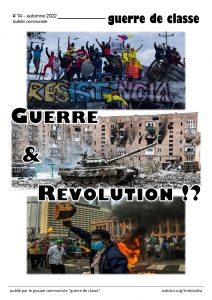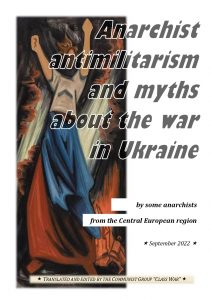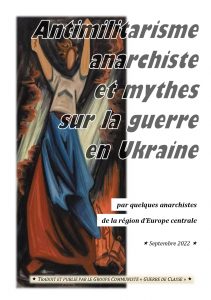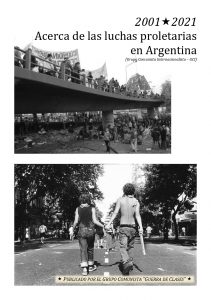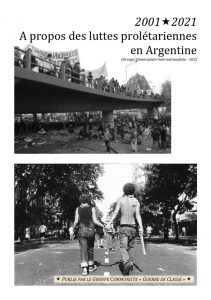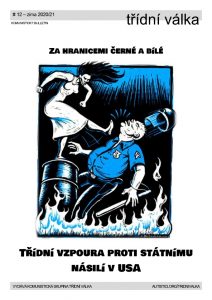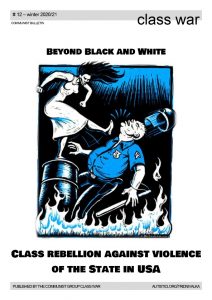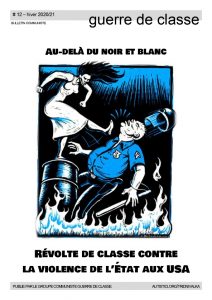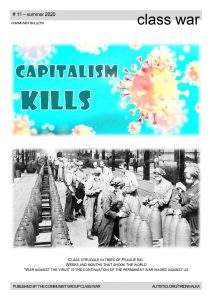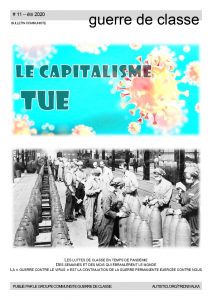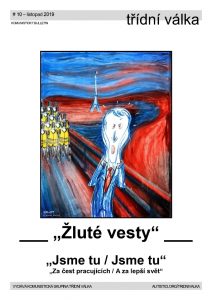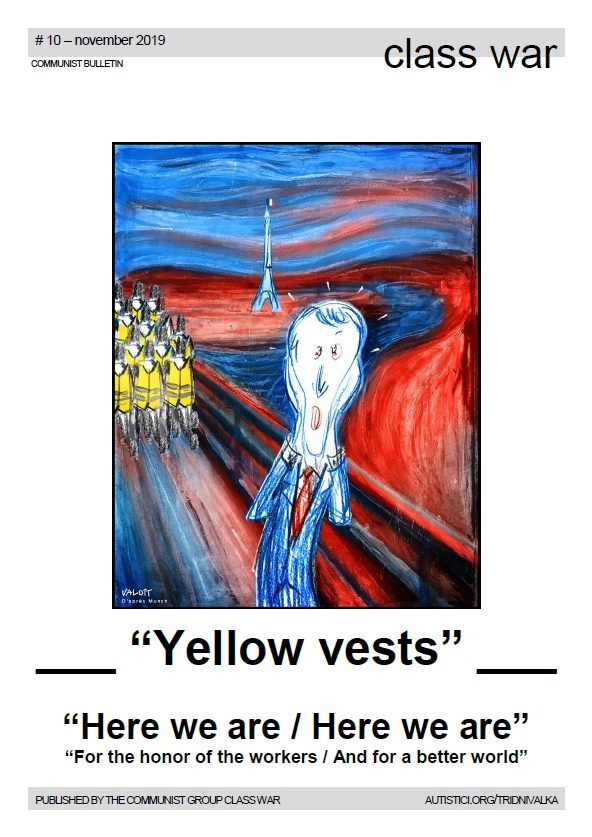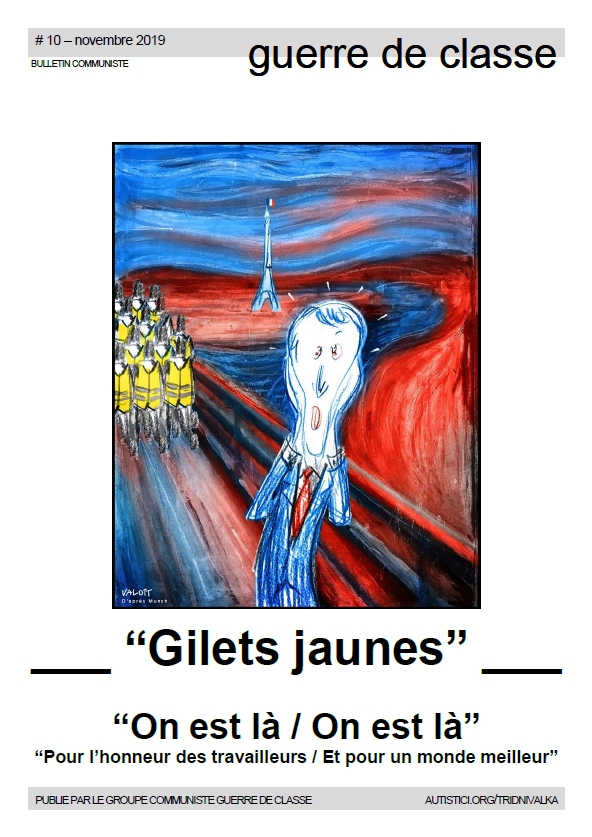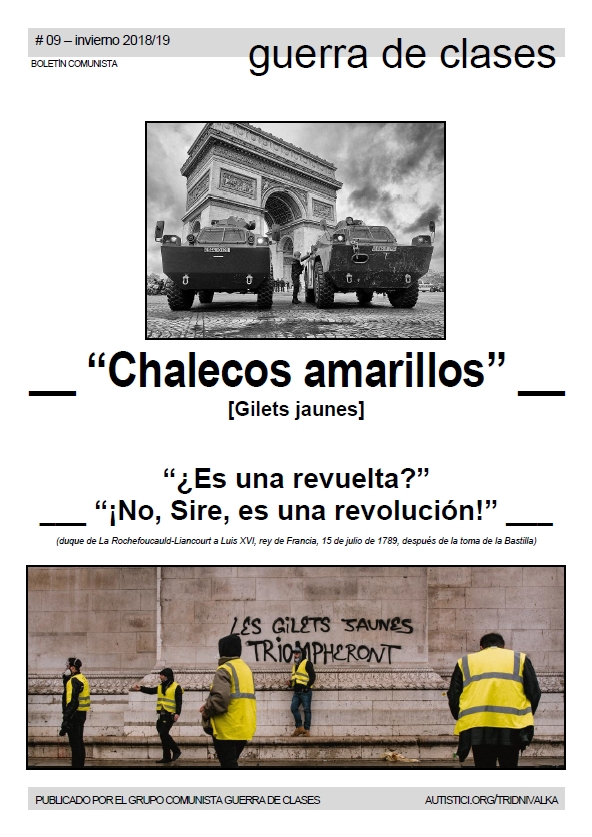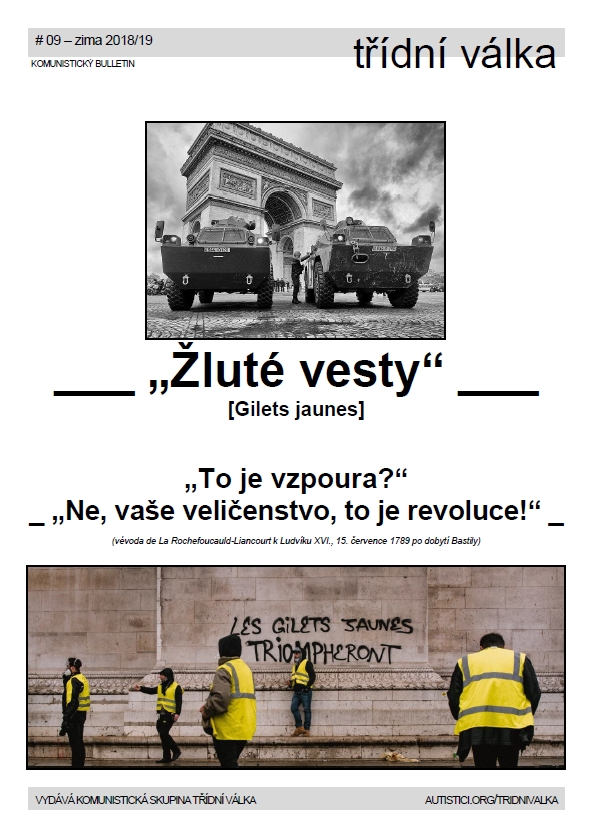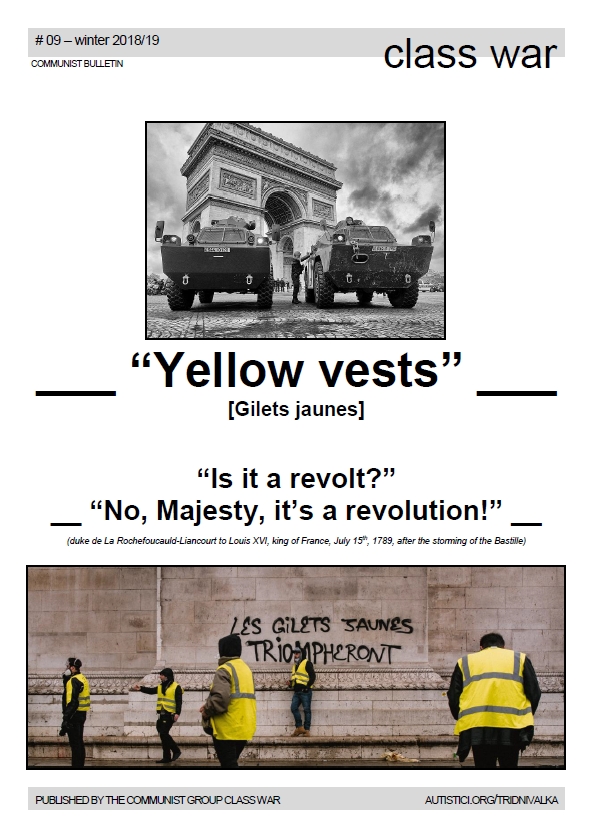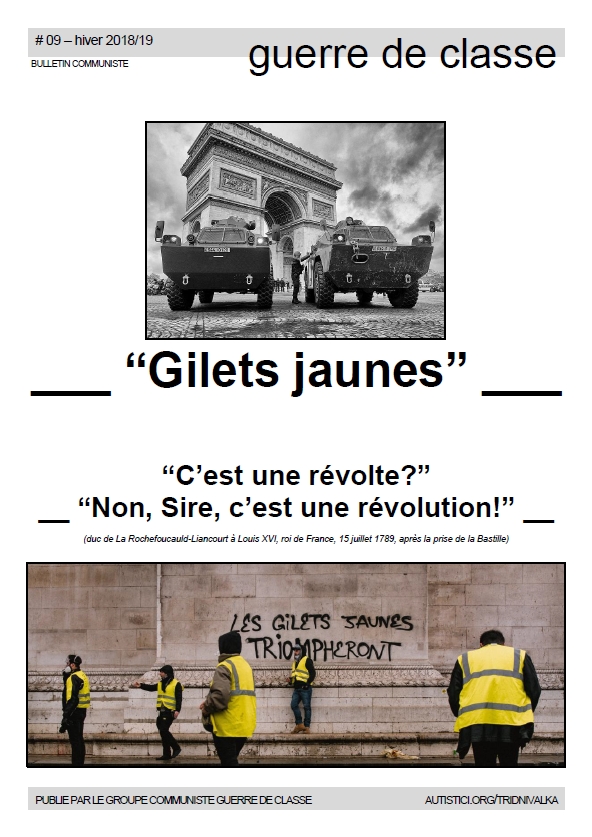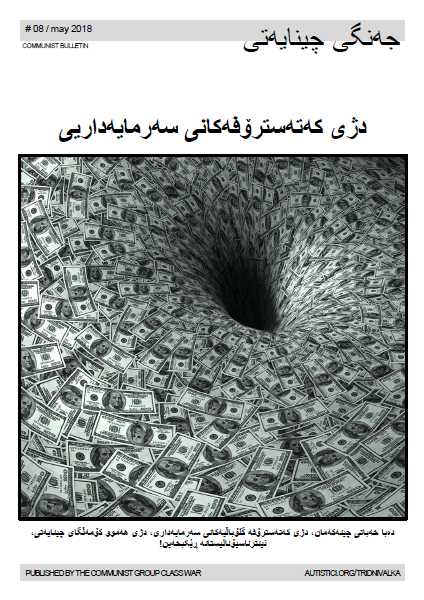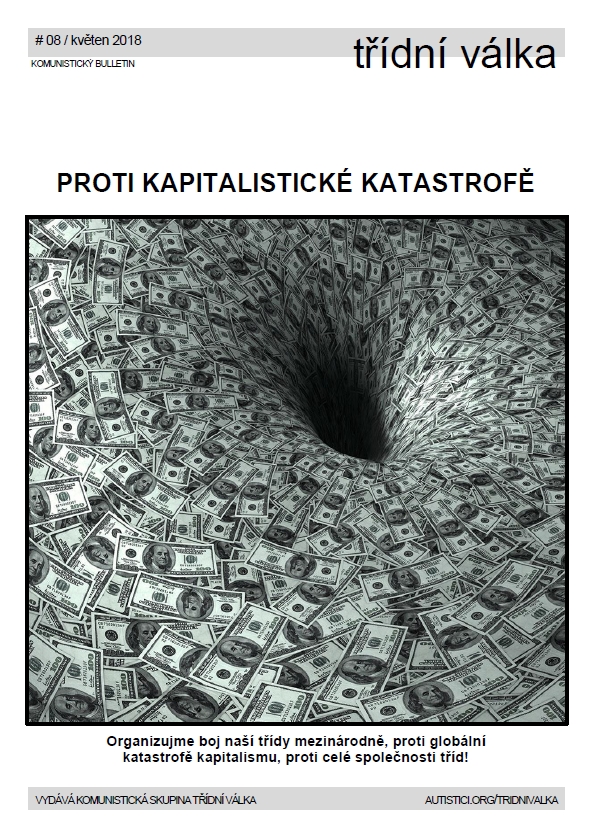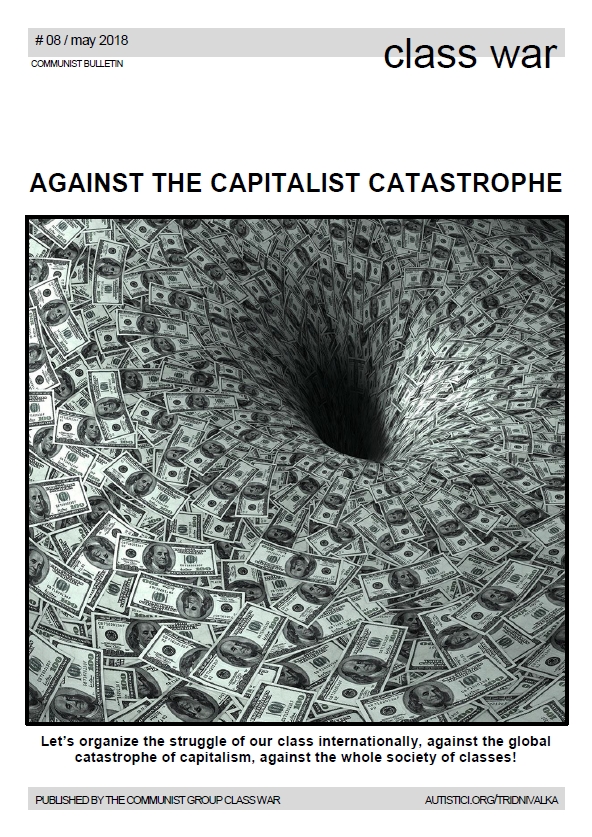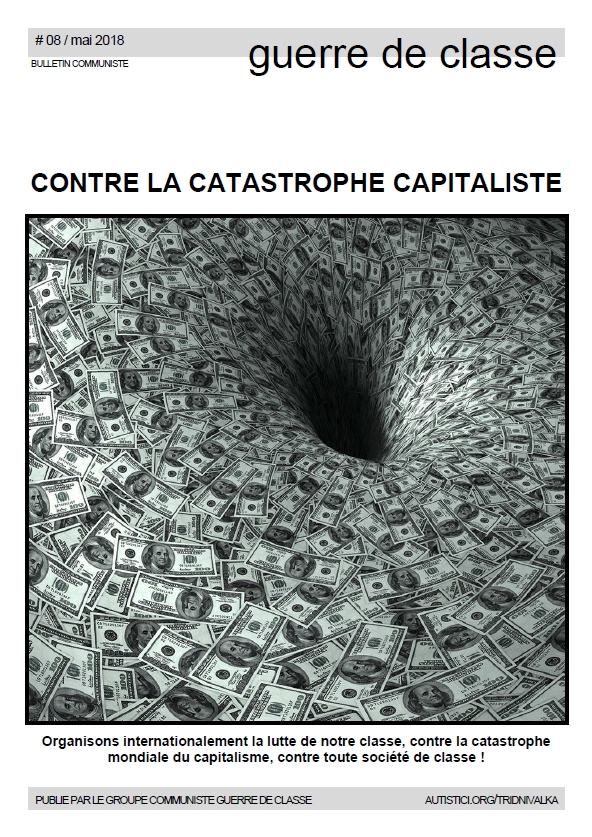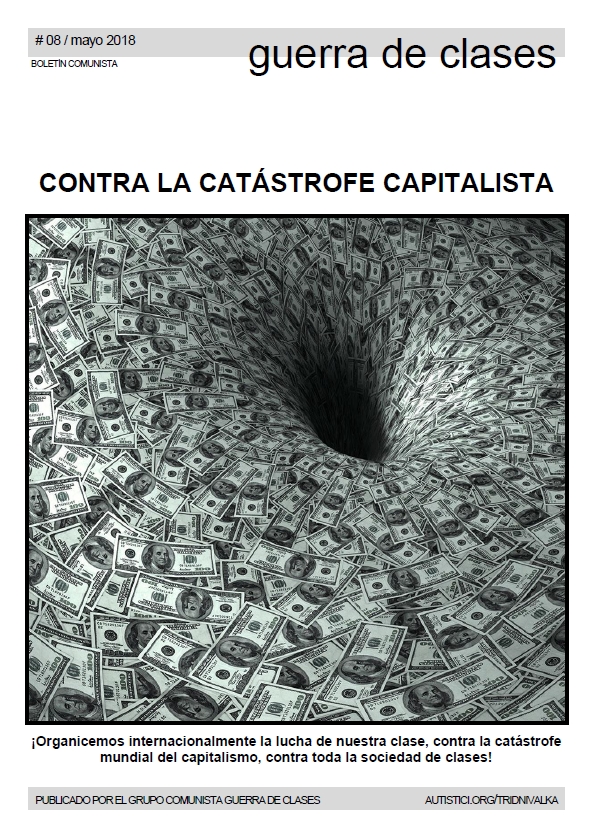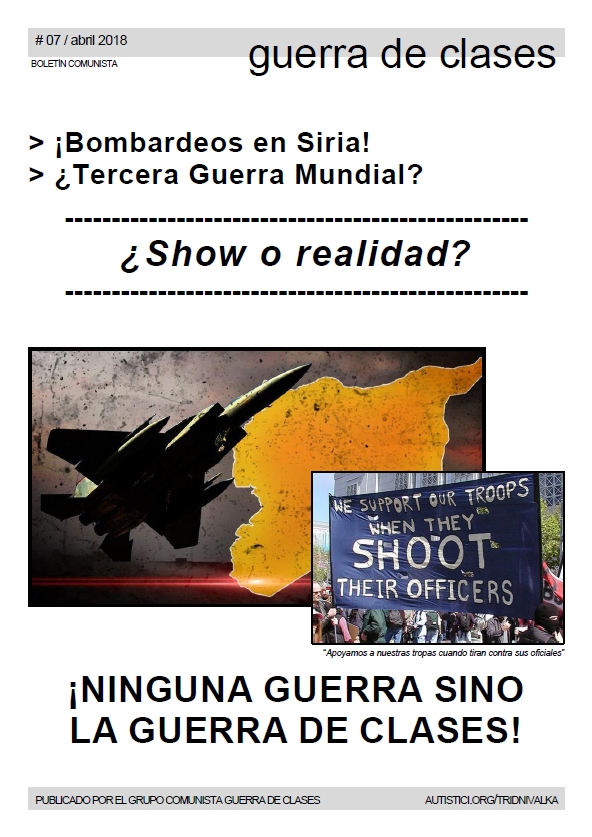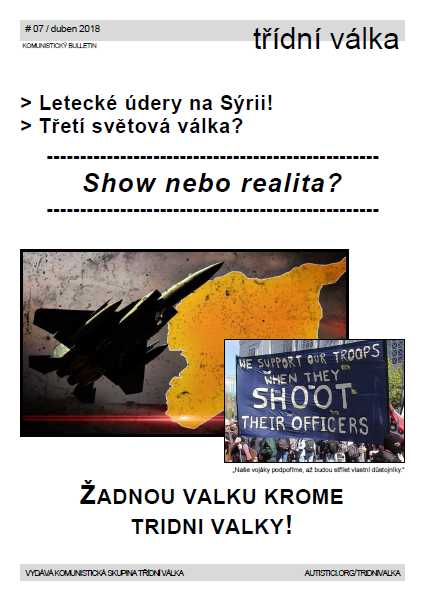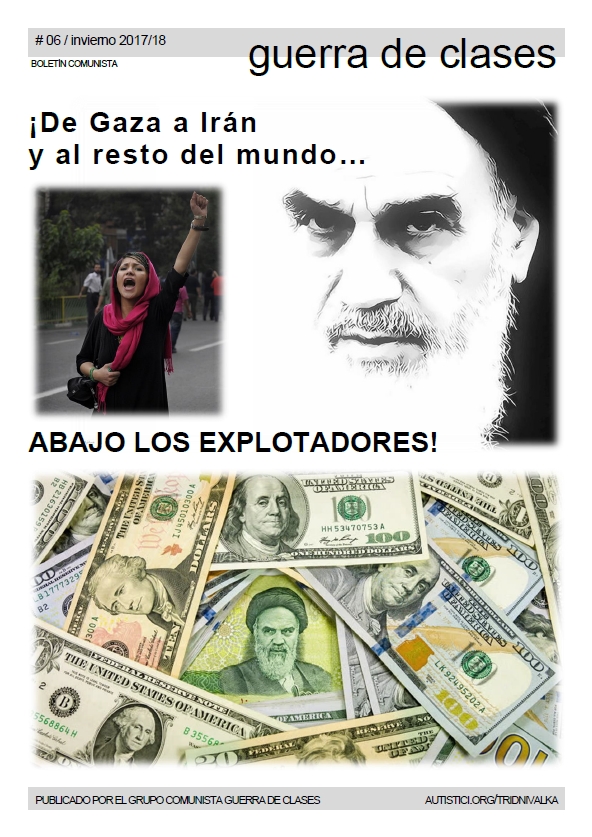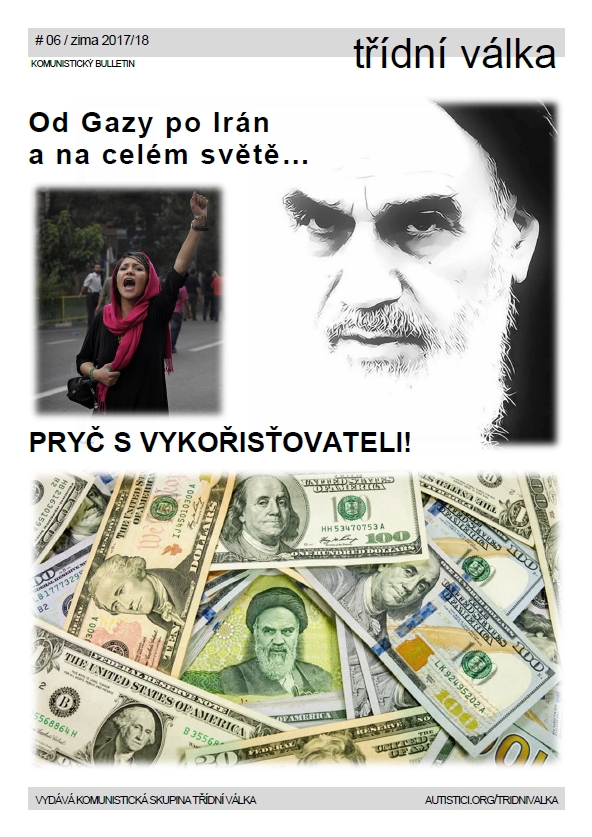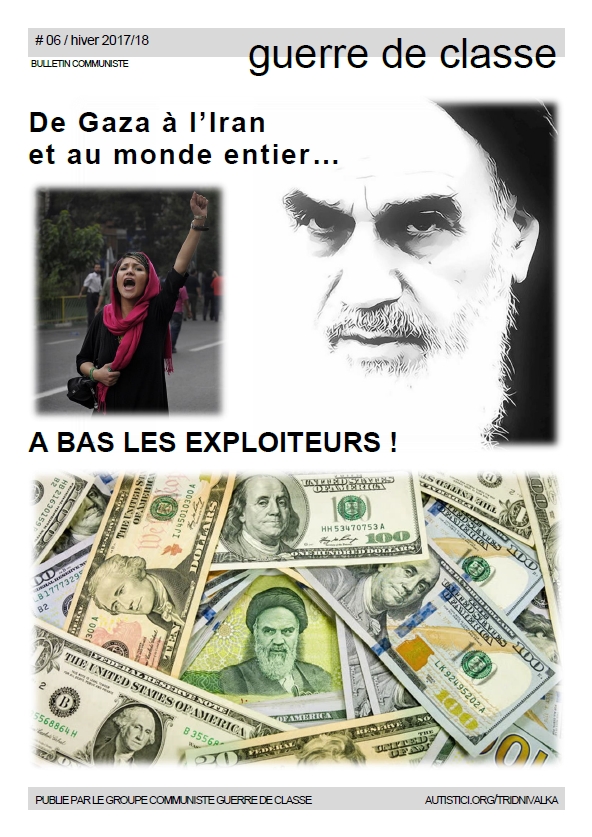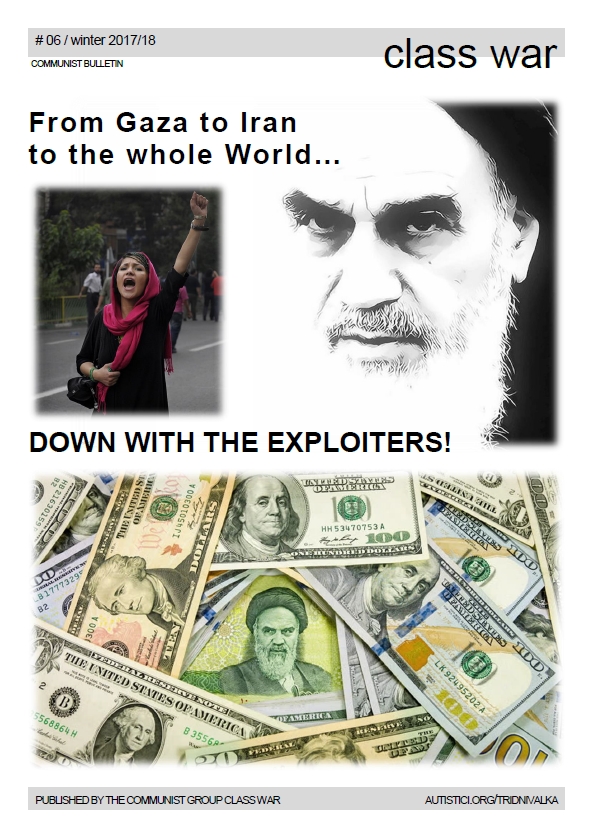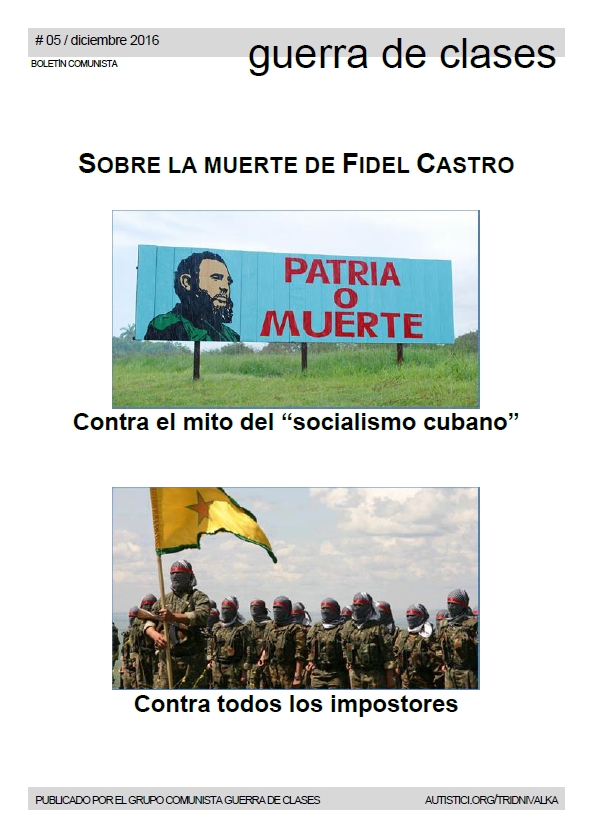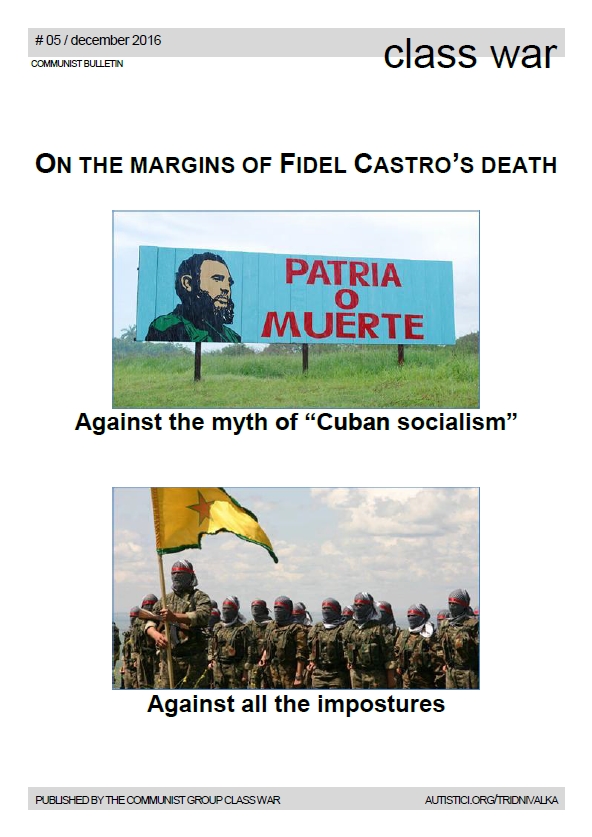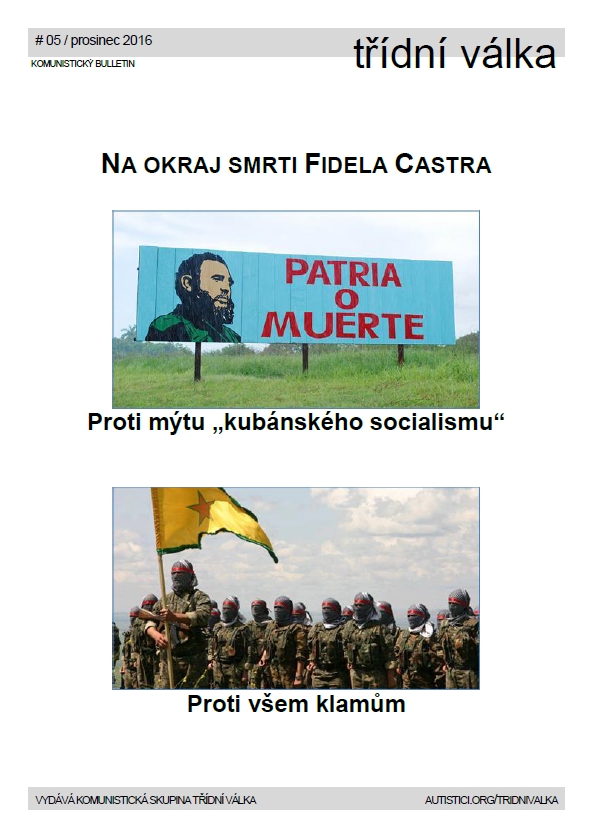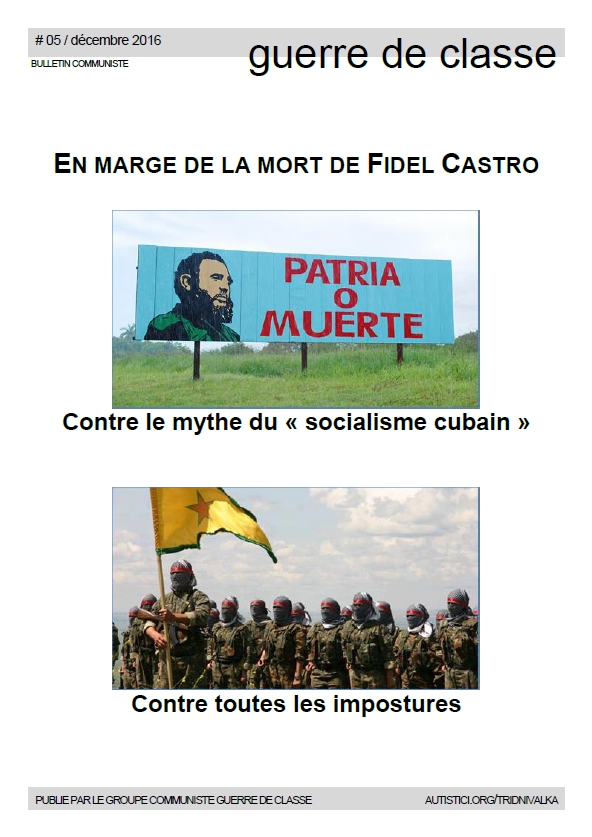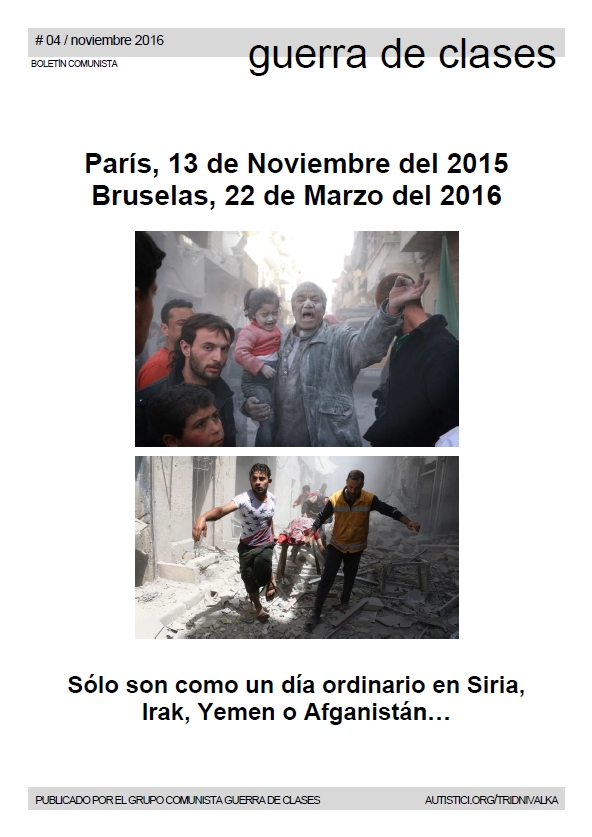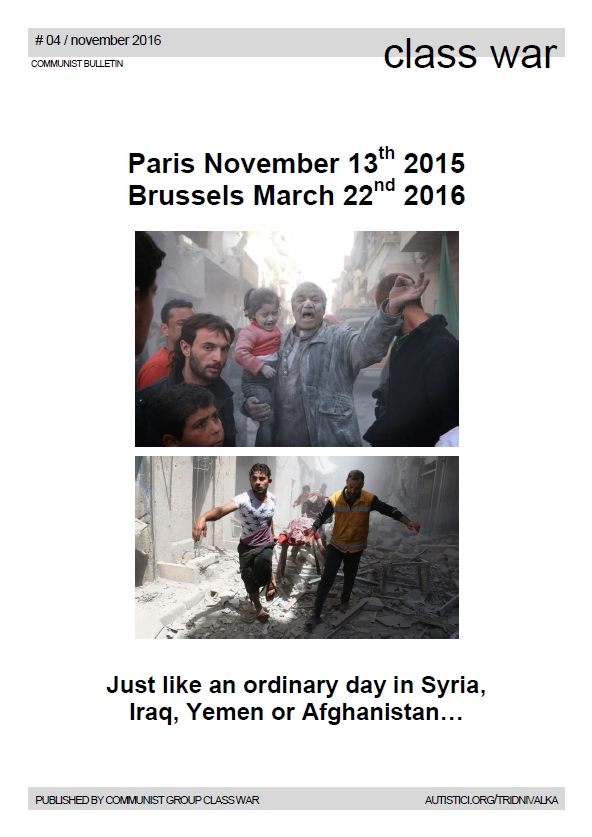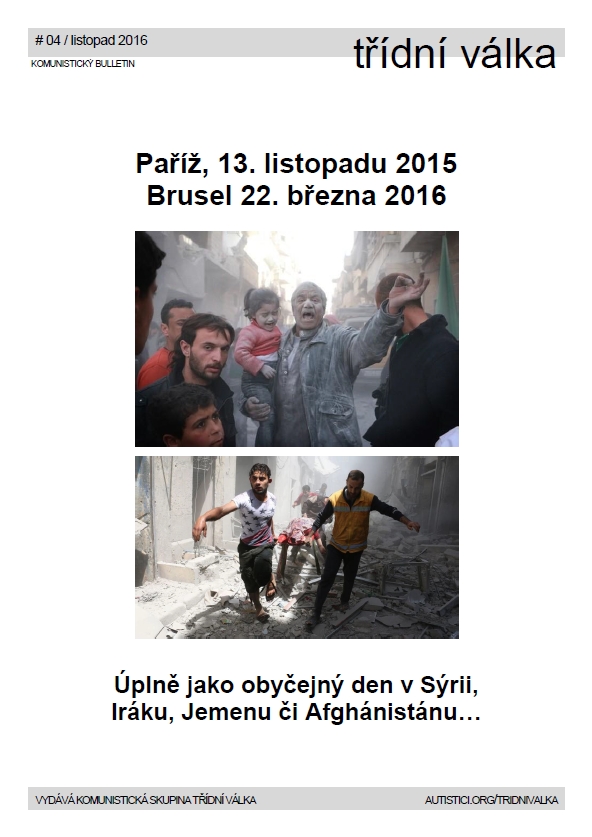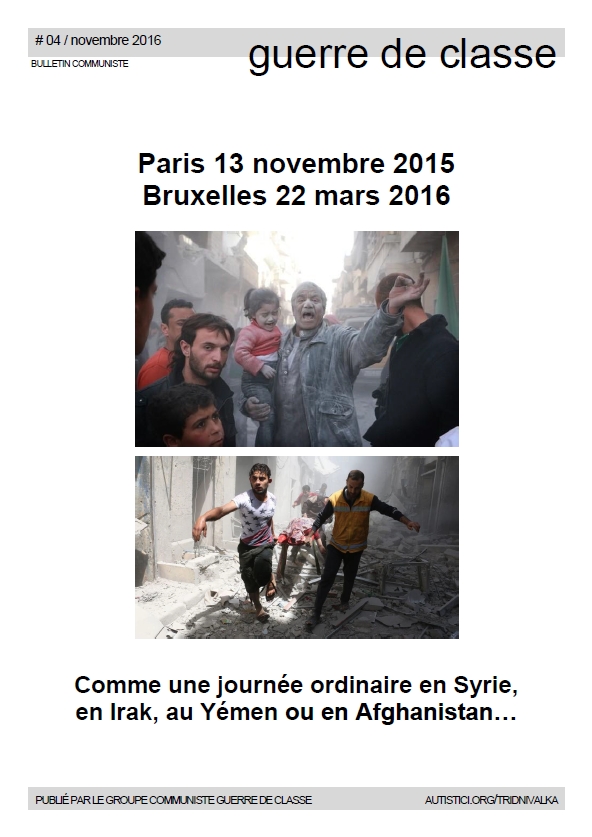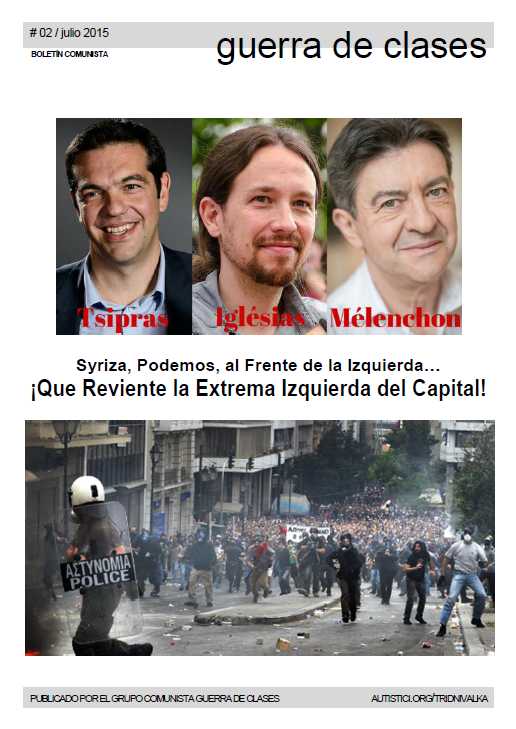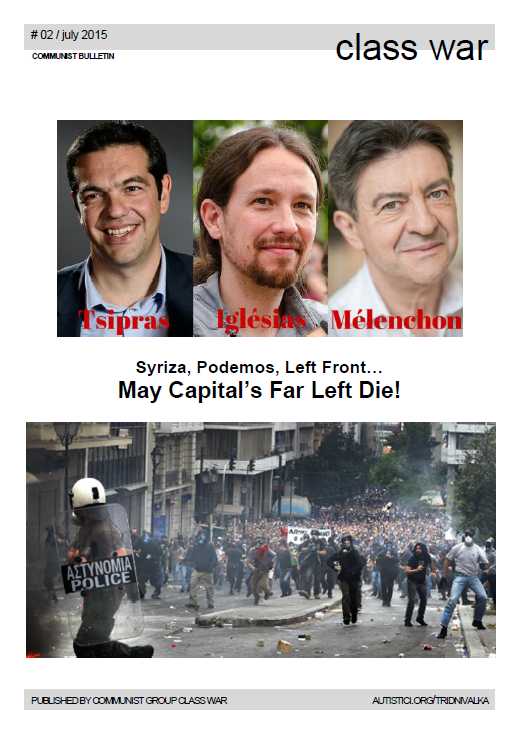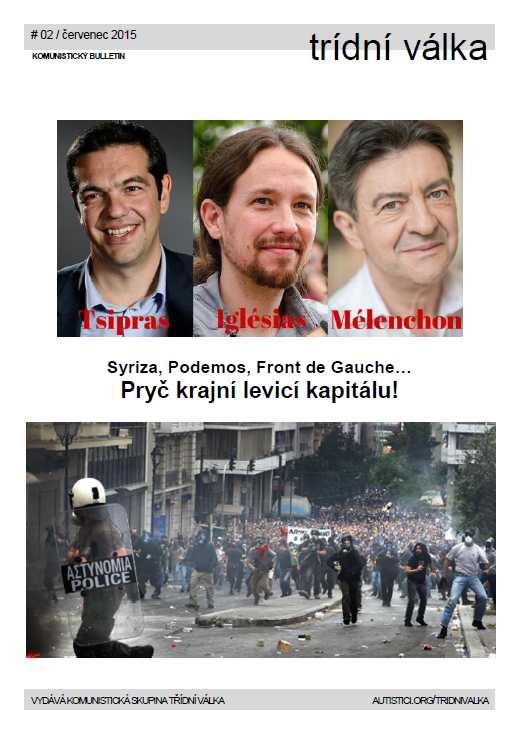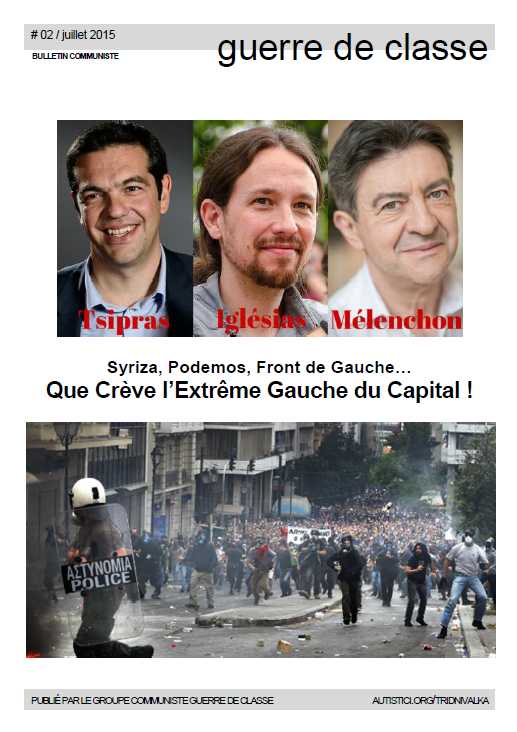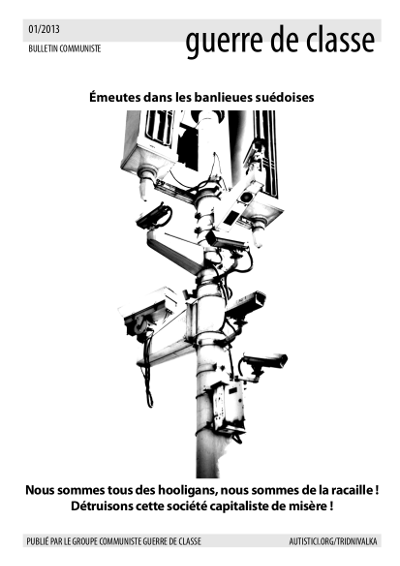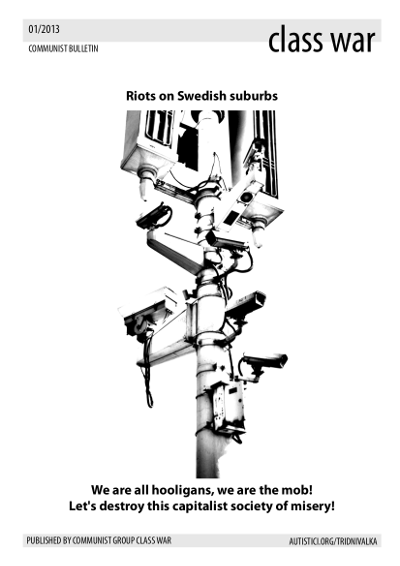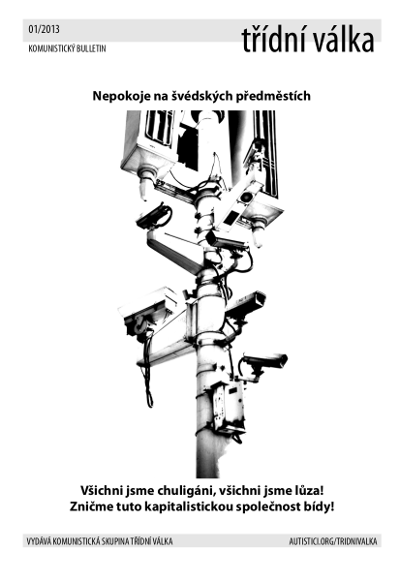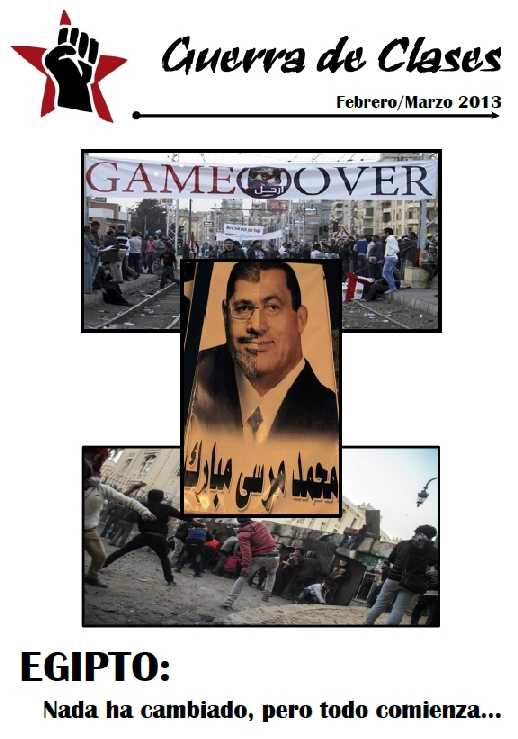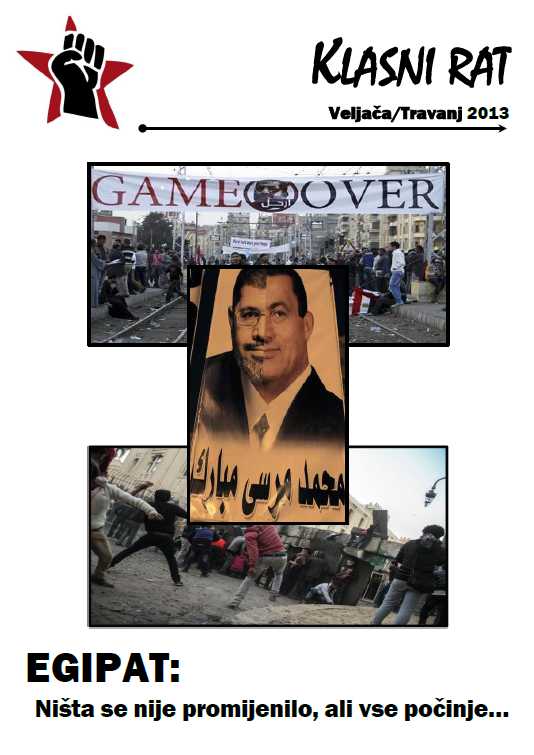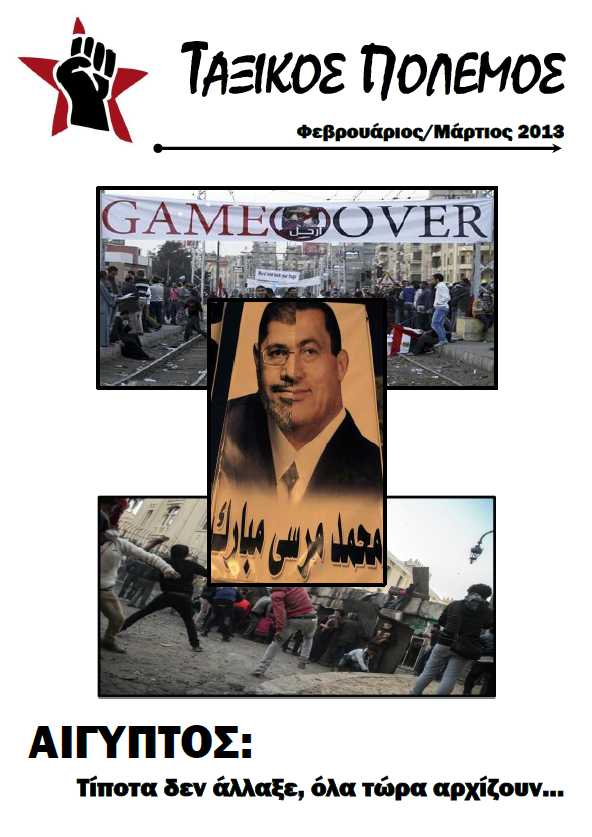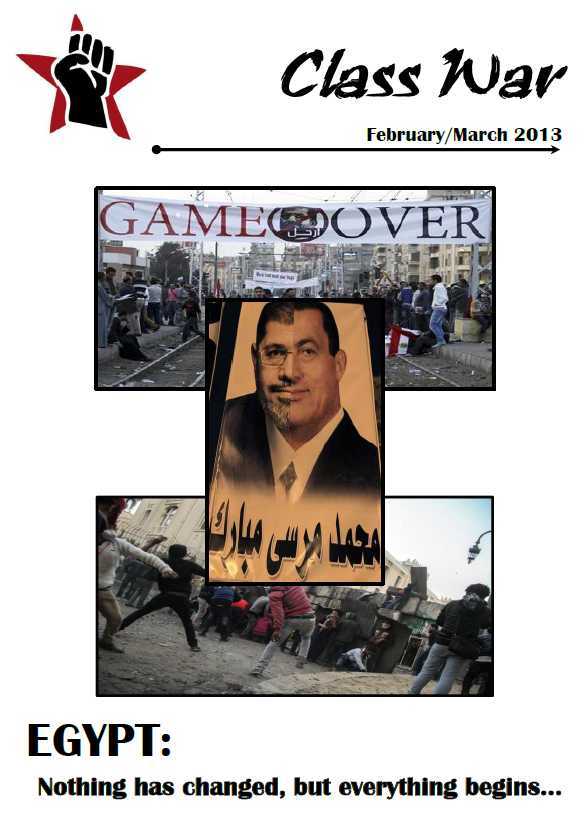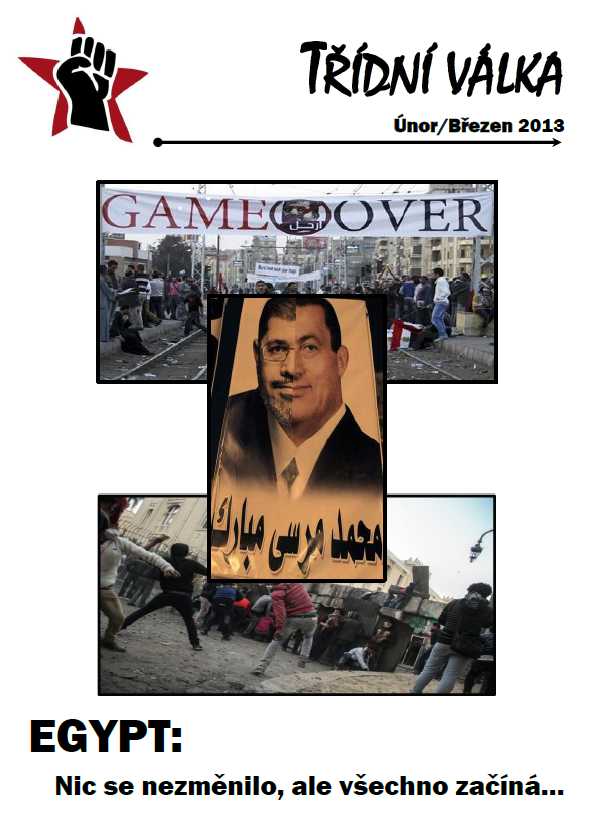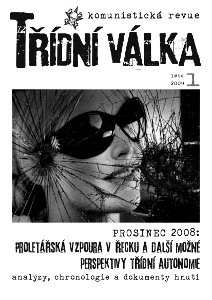| Español | Français | English | Português |
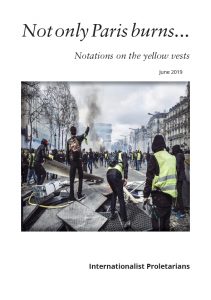
PDF A4_Light Version – PDF A5 Version
Not only Paris burns…
Notations on the yellow vests
Introduction
If there’s an image which is habitually repeated in the yellow vests movement, it’s that of demonstrators that break a police cordon, or expel the riot police in a hail of rocks, or simply organize a barricade in order to block the street and sack the luxury shops, while with open lungs and full of adrenaline they proudly sing the hymn of La Marseillaise. It’s a great image for expressing the confused and contradictory nature of the movement. In any demonstration there can be found vindications of the Citizens’ Initiative Referendum (RIC) and for leaving the European Union in order to defend the national economy. At the same time, some french and regional flags wave here and there with a certain parsimony. All of this cohabiting within the movement with constant aggressions against private property, with the sackings and pickets, the creation of threads of solidarity, the appropriation of meeting places and proletarian associationism: definitively, the practical questioning of democracy. All the while, you can see everywhere a strong vindication of the nation and its symbols, among them the French Revolution, which at the same time plays the role of symbol of national pride and of the uprising against the tyranny and misery.
The yellow vests are –if anybody had still doubted it– a proletarian movement. As in every proletarian movement, within it is expressed both the actually existing proletariat and at the same time the world which it anticipates. The first one stems from the current confusion, from our weakness as a class, from the lack of memory which the conquerors expropriated from us, the defeated. But it also stems from the inevitable, instinctive defense of some necessities which capital must deny in order to reproduce itself. This defense of its necessities pushes the proletariat to negate both capital and its dominion over our lives, and not only that, because in this process the proletariat also negates itself, reaffirming itself as a community of struggle against its own isolated, civic, democratic existence. This contradiction, essential to capitalism, inherent to its very reproduction, is what determines the possibility of revolution. It makes of it something material, physical, alien from our individual wills and consciousnesses. This is how the proletariat in its combat anticipates another distinct world, at the same time that it continues dragging along a portion of the shit of this one, which will constitute the basis of its defeat if it doesn’t manage to overcome it in the process.
Be that as it may, this contradiction cannot be ignored by any militant analysis which seriously posits the characteristics of the movement, its advances, limitations, and the role which the revolutionary minorities acquire within it. There are two perspectives, two sides of the same coin, which often reemerge in the analysis which is made about our class and which incapacitate us from understanding this contradiction. The first is idealist and reduces the movement to what it says and thinks of itself, omitting what it does in order to remain with the flag which it waves and which it casts away at the smallest social-democratic demand that appears in its leaflets. The second is objectivist and tries to understand the nature of the movement starting from its sociological composition. Scalpel in hand, it takes individual for individual and places them in one column or another on the basis of their wage, their position in the productive system, the neighborhood in which they live or the studies which they have made. Once dismembered, all is sewn together in a very statistical manner and from the result of that it is attempted to see the totality: we have here, under this ideological prism, a petty-bourgeois movement which has managed to place a sullied proletariat in its pocket in order to defend the national economy. And Voilá: the movement of the yellow vests. Enough said.
Together with these two perspectives, which often come combined, there has appeared in these last few months another, of an antifascist character, which retakes the idealist and objectivist vision which we have just finished pointing out in order to throw up its hands in outrage at so many french flags and so much Marseillaise. It reduces the movement to the groupuscules of the extreme right which court it and recalls with nostalgia the processions of the good old days, which were clearly leftist, in which the CGT delivered the hooded demonstrators to the police and the “unbowed” melenchonists took out –there, without issue– their french flags for a new republic.
Fortunately, the movement of the yellow vests is something else. Now then, although we have affirmed the proletarian character of the movement, despite all the ideologies and flags that float amongst its protagonists, that doesn’t mean to say that those things will not have importance or will not be determinant in the end. To the contrary, starting from the real practice which determines the movement and confers it its class character, we perceive and criticize all those forces of the enemy which act to entrap it, neutralize it and give it a direction which is opposed to the very necessities and interests which determine the movement itself. Without this comprehension of the reality nothing more is done than projecting distorted images of the movement in order to reduce it into a petty-bourgeois movement, civic, of the middle class, in defense of the “true french people”, led by groups from the right, etc. Of course we’re not going to collaborate in this spectacular projection which unites all of the efforts of the bourgeoisie in order to liquidate this movement. Our intention, precisely, is to contribute to propelling the proletarian potency which the struggle of the yellow vests contains and to denounce all the forces which block its development.
What the movement does
Towards the end of October of 2018 one could sense a feeling of a general malaise due to the announcement by the government of Macron of an increase in taxes on gasoline. Facing the attempt of the bourgeoisie to make us pay for the ecological and social catastrophe upon which their dominion is based, blockages of roads and organized pickets around the roundabouts begin to be produced. The ecologist movement, a social-democratic current wherever one can be found, calls to change the car for a bike if the increase in the price of gasoline was so painful. Of course, going to work on bike at six in the morning at a distance of 40 kilometers is not so easy. It’s not easy either to do the monthly shopping at the nearest market, which is a huge building 10 kilometers away, on bike, but that doesn’t seem to bother them.
The beginning of the movement, centralized for the first time in the mobilizations of the 17th of November, disconcerts everyone. The massiveness of the demonstrations and of the road blockages frightens the bourgeoisie. The roundabouts become places of meeting and of discussion. Also, the first attempts are made to separate the proletariat. There is talk of a revolt of the country against the city, of the provincial petty-bourgeoisie –essentially poujadist1– against the bourgeois bohème2, of the reaction of the petrol fan against the good faith eco-progressives and, with a greater intensity than any of the preceding, of the whites against the blacks and arabs, of the blanche-d’en-bas3 France against the overcrowded migration in the suburbs of the large cities. At the same time, Le Pen as much as Mélenchon try to capitalize on the movement and declare their support –when the development of the movement arrives to its highest peaks of combativeness, they will keep to an uncomfortable silence.
But the efforts are in vain. If anything characterizes this movement it is its vitality, its capacity of resistance facing the repression, both physical and ideological, at least the most direct. The following demonstrations or “acts”, one every Saturday, will be true proletarian manifestations –neither called nor callable by any State apparatus– which will quickly surpass the fight against the tax on gasoline. The movement begins to spread out. It begins to speak of a life which is too expensive, salaries which are too low, of permanent poverties and uncertainties which allow breathing space for no-one and put the possibility of surviving in this world in doubt. But speaking is not the only thing which is done. Some road blockages become pickets against the large platforms of commodity distribution, often in consonance with a portion of the workers. The first demonstrations are produced in the most wealthy neighborhoods of the big cities and they turn them into the ideal scenery for the direct attack against private property. In the island of La Réunion, french “overseas department”, the struggle acquires a greater intensity, though more brief due to the greater scale of repression. For two weeks the yellow vests will close the port, creating a shortage in the island which is accompanied by organized sackings and riots, as well as the closing of businesses, schools and universities. The situation becomes so uncontrollable that the government has to impose a state of emergency and send the army to crush the mobilization.
Facing the racist and anti-immigration expressions which arise at the beginning of a portion of the movement, and which serve as a loudspeaker for the groups of the extreme right, the struggles in La Réunion will give an example of the unity of class transcending that of the races. After the first demonstrations, the Comité Adama Traoré4 will call for participation in Act III, the demonstration of the 1st of December, which will become an all-out battle against the police. Barricades, sackings, burnt cars and attacks on banks and businesses blight the rich neighborhoods of Paris. The Arc de Triomphe, one of the greatest national symbols of the Republic, is sacked in its interior and on its face is written “The yellow vests will triumph”, “Resign Macron”, “Increase the Minimum Wage”, or “Justice for Adama”. It’s a complete scandal. At the same time, the police forces relentlessly attack the demonstrators. That single day in Paris more rubber bullets are shot than in the whole of 2017. The toll is 250 wounded, with various eye and hand injuries and a man in a coma, and more than 300 arrested, a number which will increase to almost 2,000 in Act IV. After this demonstration, the movement extends to the institutes and many of them are blockaded by the students, especially in the northern zone of the parisian suburbs. Throughout the following weeks hundreds of institutes will be blockaded or at least will have their activity seriously disturbed.
Carrot on a stick. On the 5th of December Macron retires the tax increase on gasoline and on the 6th the minister of the Interior, Castaner, announces that 90,000 riot police will be mobilized for Act IV, as well as tanks of the likes used in the eviction of the ZAD in Notre-Dame-des-Landes. The following day a video is spread in which the police humiliate many dozens of students of the institute in Mantes-La-Jolie, putting them on their knees with their hands on their heads. The repression of the demonstration of the 8th of December is so brutal that the strategy of the government to distinguish between the casseurs -the violent ones- and the “good and pacific citizens with yellow vests” becomes more and more unsustainable. The movement begins to organize against the repression. The networks of legal aid are extended to the arrested and groups of street medics (people with some knowledge of first aid who, in the demonstration, distinguish themselves in order to help the injured) are created. And the fact is that the movement today, at three months since its start, counts with more than 3,000 injured, among which are found many dozens of people who have had an eye ruptured or whose hand has been ripped apart by a shock grenade. The level of repression greatly exceeds the limits of what is accustomed to in Europe, and this has driven a massive development of the solidarity with the injured. In many demonstrations, a large number of people wear bandages on their eyes or on their head with fake bloodstains, as a form of denouncing the police violence.
The 10th of December, Macron announces an increase to the minimum wage, which ends up becoming an increase in aid to some precarious workers. The following day an attack is made in Strasbourg which is claimed by the Islamic State, which Macron will try to utilize in order to quell the movement, calling without success to not demonstrate on that Saturday and incidentally increasing the presence of the police forces in the street. Nevertheless, the mobilizations continue to unfold and the government has to shell out a 300 euro bonus to every cop so that they do not relent in their commitment to repress the demonstrators, who oscillate between violent confrontations with the riot police and calls for them to show solidarity with the movement.
To the contrary of the many voices which announce the end of the movement with the increase in financial aid and the retiring of the tax, as much as for the strong repression and the many thousands of arrested, the yellow vests don’t lose their vitality. 2019 will begin with a demonstration on the 5th of January in which many demonstrators use construction machinery in order to tear down the door of the ministry of the Secretary of State, allowing them to enter the building and generate a lot of damage. The Secretary of State has to be evacuated. The unions will try to capitalize on the movement, calling for a strike on the 5th of February, but the following will be minimal and the presence of the yellow vests, rather scant. Days later, on Saturday the 9th of February a demonstration is called which retakes the line of not being in communication with the authorities, in order to counteract the tendency towards the democratization and pacification of the previous acts, which had corresponded to a displacement outside of the rich neighborhoods and a diminishing of the sackings. And it works. If anything is repeated during this act XIII, it’s that in order to be heard, the confrontation is necessary.
The movement learns. The following demonstrations will return to the rich neighborhoods of the Parisian east and will have their point of culmination in the act XVIII of the 16th of March. This convocation is made during the end of the “Great Debate”, a process of participative democracy opened by Macron in order to –in vain– calm the movement. At the beginning the “Great Debate” is simply a motive for ridicule, but at these heights it already starts to become irritating. Act XVIII has at its watchword “Ultimatum”, which takes a literal enough meaning: Paris will become the scene of an all-out battle the likes of which had not been seen until then. It is attempted to again take the Arc de Triomphe, and when the police manage to impede this, the proletarian rage is directed against the luxury shops and restaurants in the Champs-Élysées, which will burn throughout the whole night.
The bourgeoisie also learn. The situation will be so incontrollable that Macron days later deposes the chief of police and places in charge Didier Lallement, well known for his repressive abilities. At the same time, the riot police force is reinforced with soldiers from Operation Sentinel, a military body created after the attack on Charlie Hebdo in January of 2015 and specialized in the fight against terrorism. From then on, all demonstrations which are produced in the immediate vicinity of the Champs-Élysées are prohibited and strongly repressed. Nevertheless, and although the presence of the police grows in the streets and the repression again erupts, in the following weeks a “yellow and black” 1st of May is called for, in reference to the joint action of yellow vests and the black bloc, and Paris will burn once again. Currently the number of arrested has elevated to 8,700 persons – according to the Ministry of the Interior – and almost 2,000 condemned, of which some 40% will serve prison time. To this must be added the putting into practice of the anti-casseurs law, which scandalizes even some fractions of the bourgeoisie itself in permitting preventative detentions of persons suspected to be capable of committing a crime –a gruesome nod to the film Minority Report– during the demonstration.
Of course this whole revolt doesn’t come from anything new, nor is it a unique and absolutely spontaneous creation of the yellow vests. In reality, the forceful combativity and the capacity for resistance and mutual aid which is demonstrated by the movement comes from a previous lesson of the proletariat in France. As such, the memory of the revolt of the banlieues of 2005 and the forms of organization which unfolded in that moment is kept alive.5 On the other hand, the struggles against the Labor Law in 2016 generated a series of experiences and learnings on the inside of the black block which are not to be underestimated, at the same time that they opened up to persons who hadn’t participated before and made call-outs to militants from other countries like Germany and Italy to join some convocations, as was the case of the 1st of May of 20186
In parallel, in the course of these months things go further than the roundabouts and assemblies are formed throughout the country. Those of Saint-Nazaire and Commercy will function as the motor for this process, making various calls for the creation of assemblies and the appropriation of spaces for meeting and proletarian association, fundamental not only for the discussion and common reflection, but also for the construction of threads of solidarity with the arrested and the injured. At the same time, and facing the necessity for mechanisms for centralization of the movement, a process of coordination is started among different assemblies which will make way for an “assembly of assemblies” the weekend of the 26th and 27th of January, and a second one from the 5th to the 7th of April.
What the movement says
What the movement says and thinks of itself is heterogeneous and confused. This is natural and reveals its massive and genuine character, at the same time that it reveals the situation of weakness in which our class finds itself in this period. The absence of proletarian memory and the current force of citizenism causes the yellow vests to identify themselves more as the people against “those on top” than as the proletariat against the bourgeoisie and its dogs. This doesn’t impede them from fighting as such, as we have seen, given that their development itself pushes them towards the confrontation with the State and private property, but without a doubt it’s a banner which weighs upon our heads and which opens the door to the different forms of bourgeois recuperation.
At the same time, it’s important to not make a homogeneous bloc stemming from the majoritarian wing of the movement, forgetting all the struggle at its interior to clarify and impose our interests. Without a doubt the dominant ideology is that of the dominant class, even in a process of struggle against this very class. Nevertheless, the vitality of a movement is measured also by the minorities that try to point out and combat the traps of (social)democracy, while at the same deepening the radicalism of the movement itself against the system. That’s why it’s important to highlight voices like those of the call-out from the yellow vests of Eastern Paris, where it is told clearly that
“We are not this “community of destiny”, proud of its “identity”, full of national myths, which has not been able to resist social history. We are not French.
We are not this mass of “humble people” ready to close ranks with their masters as long as they are “well governed”. We are not the people.
We are not this aggregate of individuals who owe their existence only to the recognition of the State and for its perpetuation. We are not citizens.
We are the ones who are forced to sell their labour force to survive, those from whom the bourgeoisie makes most of its profits by dominating and exploiting. We are the ones who are trampled, sacrificed and condemned by capital, in its survival strategy. We are this collective force that will abolish all social classes. We are the proletariat”.7
But before that, if there’s anything which characterizes the yellow vests positively it’s their rejection of all forms of representation. This is in fact one of the factors which nurtures their vitality as a movement. In the first place, the rejection of the mass media is total. Its role in the ideological propaganda of the government is denounced and confrontations and even expulsions of the mass media journalists who allow themselves to be seen in the demonstrations are produced.
At the same time, there’s a profound refusal of political and union representation. The rejection of the unions is so much more notable due to the powerful sway that they hold in french politics. In the last years of demonstrations, never has there been seen such a delegitimization, although the creation of cortèges de tête in the struggles against the Labor Law in 2016 started to announce a search for autonomy with respect to them, although in a minoritarian form. This is certain even if the declaration of the “general” strike on part of the CGT on the 5th of February, as an attempt of union channeling of the struggle, had support on part of the most visible voices of the movement. The strike of the CGT put into an evident contradiction those who had earlier rejected the presence of the unions and now welcomed their convocation as if it were a way of extending the struggle to the workplace. Nevertheless, as we have said before, the strike was very sparsely followed and the number of yellow vests in the union stroll was rather scant.
In the demonstrations of the unions, with the exception of the leftist SUD-Solidaires, and that one timidly, they don’t dare to appear with either banners or stickers. In fact, there are few prefabricated banners, and the different assertions which each yellow vest decides to write on their back with a simple marker fulfill this function. The necessity of defending the autonomy of the movement is very present among the demonstrators and the attempts at capitalizing on it politically have been a true failure, such as the inscription of an “electoral list of the yellow vests” for the european parliamentary elections or the organization of the municipal governments to gather “notebooks of complaints” –a nod to the cahiers de doléances of the French Revolution– with the aim of organizing the “Great Debate”.
Nevertheless, this rejection of representation has its counterpart. Despite it containing this sanitary cordon against the classical bourgeois framework, it contains at the same time a negation of the community of struggle, of our collective proletarian being. It stems not from the community of struggle, but from the isolated individual who represents themself and therefore negates the collective expression and its distinct forms of materializing itself. It’s the terrain which allows passing over to democracy, especially direct democracy. It hides, on one side, the idea that only the individual can represent themself and that ultimately, the only way to organize this conjunction of isolated individuals is with forms of direct democracy, voting, formal processes examined to the detail, empty vindications fashioned so that not one individual is left out: definitively, it is expressed in the assemblyism which is most castrating to the action of the movement. On the other hand, this rejection finds its ideological expression in a populist discourse by which the people have to assert their sovereignty by refounding a new form of democracy. It is here where the Citizens’ Initiative Referendum (RIC) shows itself as an excellent instrument of recuperation. “Goodbye to the war of egos and to the war of power. With the RIC now nobody has the power, it’s the whole population who has it”, says Maxime Nicolle, one of those who the press has declared as “leader” of the movement. If the democratic ideology is in itself one of the most ingrained bourgeois forces, one of the last barriers which we must surpass in the process of the constitution of class, it takes on new vigors in the context of the weakness in which we find ourselves, in the difficulty of recognizing ourselves as proletarians and of feeling ourselves to be one sole class at the global level. As such, the democratic defense of sovereignty is reinforced in the identification of the capitalist catastrophe with the “phenomenon of globalization” and the nationalist rally which is given as a response on part of the social-democracy, be it more to the right or more to the left.8
Despite the majoritarian presence of the RIC, it’s not because of it that there is a lack of voices which warn of the risk of recuperation which it contains. Such is what the yellow vests of Toulouse for example do by speaking of “RICuperation” in their periodical Le Jaune [The Yellow One]:
“The RIC has surfed on this illusion. It must be said that at first sight, the proposal was attractive. We were told that with this, we would finally be able to be heard directly, that we could regain power over our lives. We would decide everything. And even without struggling, without risking our lives on the roundabouts and in demonstrations, just by voting, on our computers in our living rooms, with slippers near a cozy crackling fireplace! But in business, when you have a product to sell, you lie: “Yes, once you have the RIC, it’s possible to get everything through!” That’s wrong. How the hell to ask the bourgeois for their opinion on whether they agree to increase our wages? A vote against the interest of the capitalists, for example the increase in the minimum wage per hour, would be quite simply rejected. Just remember the 2005 referendum [on the European Constitution]. And this is not to mention the intense propaganda we would suffer to vote against it, alone in front of our screens”.9
The weight of that which is national-popular in the movement, a necessary compliment for a democratic discussion, is reflected in the absence of its internationalist consciousness. It’s paradoxical, given that the yellow vests have been retaken by the proletarians of other countries to express their own struggle against the existing conditions of misery. This had occurred especially in Belgium, where the identification is more immediate due to the territorial and linguistic proximity, but also in Egypt, where the government, fearful of an extension of the movement, had to prohibit the sale of yellow vests facing the call made by different groups to celebrate the anniversary of the revolt of 2011 dressed in yellow vests in order to express that it is the same struggle. Also there appeared yellow vests during the protests in Bulgaria and Serbia –also against an increase in the price of gasoline– and those of Iraq, which had begun because of the intoxication of tens of thousands of people due to the faulty purification of the water. Nevertheless, in places such as Germany, Holland or Spain the yellow vests had been used by extreme-right groups –and also by some groups of social-democrats– without much success in mobilization. In this context, despite the internationalist nature of the movement, which is recognized by proletarians from other regions of the world, the french movement seems to be refocused on itself, on its national plane, and the references to the proletariat of other countries stand out for their absence, to the contrary of what happened during the international wave of struggles of 2011-2013.
This allows contextualizing the coexistence –which throughout the course of the mobilization has diminished– in the movement with groups of the extreme right, as well as the initial racist and anti-immigration expressions. Although, currently the presence of these forces is very relative, inflated by the hype which the press has given them, such is not the case with the calls for the defense of national industry and commerce, symbolized by small commerce, and transmitted by the call for a Frexit. In these, where many see the weight of the middle class or the petite-bourgeoisie, which would be directing the movement or, at least managing to introduce their own assertions, we see naught but a proletariat which is barely awakened and which demonstrates at the same time -a sign of our epoch– a clear capacity for self-organization and of confrontation with the State and private property, and an enormous difficulty in recognizing itself on a global level as being one class against a sole enemy: the capitalist social relations incarnated and defended by the bourgeoisie10.
But once again at the inside of the movement a struggle is being fought against these nationalist tendencies, in such a form that in the course of the last months they are increasingly becoming weaker, and increasingly more voices can be heard which assert the international nature of the proletariat. So, for example, towards the end of December an assembly of hundreds was held in Caen, in a building occupied by undocumented immigrants during the railway strike of 2018, in a clear identification of the struggle of the yellow vests and the immigrant proletariat against the same state and the same capitalist system. On the other hand, Le Jaune warns in its second number against the attempts to separate the proletariat:
“Later, others will come to propose solutions for the management of the crisis to you which would end up crushing the proles who come from afar in order to continue exploiting those from here: strict management of the migratory flows (done), hunting of the undocumented in the territory (done), Frexit, etc. They propose to us to lock ourselves up with a double bolt and to barricade the door, as if the capitalist wolf were not already among the french sheep. When a national response is proposed to a worldwide problem it’s because it’s prepared to defend itself at the cost of the rest of the galley-slaves of this Earth, and that is precisely what the capitalists of the whole world hope from us in these tumultuous times: to be divided and to be controllable.”11
Yet although this has a role which we can’t underestimate in the limitations of the movement, it is democracy itself which, in an immediate way, presents itself as the principal factor of recuperation. A sample of this can be seen in the effect which was generated in the demonstrations by their legalization, which began to take hold starting from Act IX (The 12th of January), since until then the convocations were spontaneous and anonymous. The legalization of the demonstrations implies that there must be people who are responsible to the authorities for all the damages produced in them, for which the organizers themselves have an active interest in pacifying and maintaining order during the demonstration. Furthermore, this obliges the yellow vests to follow the route known and foreseen by the police and to establish an order-keeping service. As we have already stated earlier, pushed by the most democratic wing of the movement, the manifestations in Paris will displace themselves from the rich neighborhoods of the east, saving the luxury shops from proletarian expropriation, but also averting the demonstrators from the symbols of power like the Élysées or the chambers of industry and commerce. In these demonstrations the citizen ideology starts to become a heavy load and the demonstrators themselves turn on the groups that break the shop windows or even paint them.
This tendency of the movement to extinguish itself democratically, nevertheless, was contested shortly after in Act XIII (9 of February), which as we have explained earlier was convoked with the explicit intention of breaking from this tendency of legalization, meaning, neither declaring the route to the police nor having legal organizers, nor an order-keeping service. As well as returning to the rich neighborhoods in a new upturn of combativeness. Starting from January and in the months to follow the yellow vests will pass through ebbs and flows which will express with total clarity as much a most combative character in negation of the established order, as moments of pacification and democratization in which the majoritarian wing which we described earlier manages to impose itself.
On the same terrain of democratic channeling, another of the risks of the movement is that it allows itself to be entrapped by an assemblyist ideology. The process of the creation of assemblies and their attempts at coordination are very positive, given that they respond to a necessity of the movement to endow itself with more stable structures of association, to defend itself from the repression, to think together and to create mechanisms of centralization on a national scale. Often this entails, as in the case of Saint-Nazaire, the occupation of spaces for reunion and assemblies. Nevertheless, the pressure to provide concrete demands, unanimously reflected on a paper which represents the yellow vests on a national level, weighs down upon this centralization effort and can have the effect, finally, of withdrawing the demonstrators from the streets in order to bring them into closed rooms to discuss for hours about the way to formulate a phrase so that it represents everyone. The positive role which the conscious organization of debates and discussions plays at the interior of the movement should not be underestimated at all, but it is indeed necessary to recognize that the separation between the word and the deed, the bureaucratization of the assemblies and the verbal acrobatics for lending an ample representation imply the death of these assemblies as organizational expressions of the movement and their passing over to the counterrevolution. In fact, it’s the feeling with which many yellow vests left the second “assembly of assemblies” (5th-7th of April), where the unity of action which was expressed in the demonstrations was seen to be completely diluted, and everything turned into acrobatics in order to put out a few sheets of concrete demands where “there’s space for everyone”.
Some provisional perspectives
The tasks and activities which the revolutionaries assume are neither inscribed nor based on possibilisms, but are determined by the necessities themselves –immediate and historical– of our class. We are conscious that most probably the movement of the yellow vests will be liquidated, be it because all the limits which we have just criticized end up taking power over the movement, or due to the wearing down and folding of the protagonists. Nevertheless, our conscious and voluntary actuation for the social revolution, for the abolition of capitalism, impels us to assume this movement as one small episode more in the historic struggle against capital. And at the core of all of these episodes it is the revolutionary minorities that try to propel the movement to its final consequences.
This short text is written in this impulse as a necessity of our class to make a balance of the struggle, to express its true actuation against the falsifications of all the spokesmen of capital, to point out and take position against all the forces of our enemy, to delve into the forces and limits which we have.
If this movement has anything peculiar about it it’s that it comes to mark a certain change in the characteristics of the struggles of the recent years. From Argentina to Greece, from the north of Africa to France itself, from Brazil to the suburbs of the United States, etc., we have seen many different important struggles with the common characteristic that they presented themselves as powerful eruptions which rapidly ceased. The proletariat took to the streets violently, pushed by the sharpening of the capitalist catastrophe and it opposed itself furiously against the most visible capitalist enemies, but after the first moments, the first days, the first weeks, when the class instinct was not enough, when it wasn’t known how to continue, the bourgeoisie presented all kinds of methods –political alternation, self-managerialism, repolarization between bourgeois fractions, repression, imperialist war…– that restabilized the order. It’s certain that these methods of social pacification had been met with increasingly more resistance on part of the proletariat, but not at the level of the resistance and permanence of the protests of the yellow vests after seven months from the start of the movement. With ebbs and flows the movement has resisted the repression and the diverse attempts of channeling up until now, and it has not allowed itself to be seduced by the crumbs which the french State has gone to offer it.
On the other hand, the bourgeoisie, which until very recently was capable of enclosing the struggles in their national States, is witnessing how these walls of contention which allowed it to confront the struggles parcel for parcel are being broken down. It’s certain, as we have said before, that the proletariat in France has many difficulties in explicitly assuming the international character of its struggle, nevertheless in other regions of the world the identification with the struggle of the yellow vests openly expresses this internationalist character. This reality clearly shows that the living conditions of the worldwide proletariat tend to homogenize in the measure in which the capitalist catastrophe advances. But the process has just recently commenced.
It’s obvious that, as we said in a text from years ago, today it is of capital importance that the proletarian minorities from here or from there advance in this indispensable process of international coordination and centralization, that we break down the divisions country by country, or even worse, city by city. To do that we have to recognize that the force of the revolutionary minorities was never so minuscule, that the proletariat had never been in such a state of disorientation, that there had never been such a huge contrast between the necessity for revolution and the incapacity of assuming that necessity. It’s evident that turning this situation around is a vital necessity for the revolutionary perspective.
In any case, it’s indisputable that the movement of the yellow vests is part of an awakening process of our class at an international level, after the defeat of the wave of struggles of the 70’s. Facing the feasible perspective that this movement will die out sooner or later, if a bourgeois recuperation at the height and intensity which it has lived and fought out is not produced, it will leave behind new threads of solidarity, perhaps some structures, experiences of struggle from which to derive lessons, a new number of persons who, after their radicalization in the movement, will be added to the activity of the revolutionary minorities in spite of the return to normality. Our class learns. It constructs its own memory. It awakens.
We will not sit in wait for a supposed metaphysical proletariat, liberated from all earthly sin, pure to the depths of its soul, to take to the streets in order to announce the end of capitalism and the arrival of a new world. Nor will we wait for capitalism to devour itself in order to be able to manage its disaster. We leave these religious prophesies to all the militant devotees, to all the sacred families of the left and the extreme left of capital. The proletariat will not descend from the heavens, capitalism will not abolish itself, but rather, as always, time and again, the revolutionary alternative appears and will appear in the struggle of our class, intoxicated by the capitalist noxiousness, by all the poison which segregates this society. In this combat against everything which impedes us from living, against everything which makes it impossible for us to affirm ourselves as human beings, as the human community, where the lungs can take in a bit of oxygen amongst so much pollution and where the human community is prefigured as a community of struggle against the community of money. The proletariat is forced to destroy capitalism at its roots if it doesn’t want it to destroy our whole world. This profane and corrupted proletariat will not descend from the heavens, but will seize the heavens by assault.
Consequently, we actuate and compel all comrades and groups to defend our class interests and to combat the bourgeois framework in these protests: to the structuring and organization against all the democratic and nationalist attempts at channeling; to fortify and extend the contacts between us, to create organizational networks at all levels, structures to defend ourselves from the repression and to discuss about how to assume whatever task.
28th of May, 2019
Internationalist Proletarians
www.en.proletariosinternacionalistas.org
info@proletariosinternacionalistas.org
Notes
1. A conservative and corporatist movement of small merchants, led by Pierre Poujade in the 1950’s, that protested against the extension of large commercial spaces. Jean-Marie Le Pen would be a poujadist representative before funding the french National Front.
2. A term which makes reference to the cultivated and progressive urban bourgeoisie.
3. The “French white underclass”, the french ‘white trash’.
4. A group organized against the police violence in the banlieues, with a discourse close to racialism. It takes its name in memory of Adama Traoré, a 24 year old youth who was murdered by the police while under detention.
5. See our book “La llama del suburbio” [The Flames of the Suburbs] at www.proletariosinternacionalistas.org (currently in french and spanish)
6. This we say without disregarding all the limitations which the black bloc has, as a hyper-specialized militant tactic which, by giving so much importance to physical confrontation with the police, falls easily into the spectacle of violence – empty of class content and therefore easily recuperable – as we have been able to see in the successive counter-summits in the last two decades – in respect to this see the article “Against Summits and Counter-Summits” from the journal Communism n.14 at http://gci-icg.org/english/communism14.htm#summits . So warns also a leaflet distributed during the 1st of May this year: the sackings, the attacks on city property, the confrontation with the police,”[there is] nothing more normal and logical, nothing more sane and healthy, and it would even be distressing if none of this did not occur. But it would also be equally distressing (for other reasons, certainly) as well as damaging for the rest of the movement in opposition to the present order of things if only that were to happen and we left it at that, if we were to limit ourselves to a class violence that might turn into a spectacle of violence, if we were to go no further, not deepen the gap, the chasm that separates us from them; we, humanity in struggle, and them, the capitalists and their world, made up of misery, of exploitation, of war and of suffering.” – [“Yellow Vests (or not). For a combative 1st of May, Anti-capitalist Direct Action” at https://lille.indymedia.org/IMG/pdf/gilets_jaunes_ou_pas_mayday.pdf (fr).
An (unreliable) machine translation in english can be found at: https://enoughisenough14.org/2019/04/28/yellowvests-or-not-for-a-mayday-of-combat-direct-anti-capitalist-action/]
7. Text taken from Class War n.9 winter 2018-2019: https://www.autistici.org/tridnivalka/class-war-09-2019-yellow-vests/
8. See the text from Barbaria «Más allá de la extrema derecha» [Beyond the extreme right] at http://barbaria.net/2018/12/20/mas-alla-de-la-extrema-derecha/. (currently only in spanish)
9. The original text in french can be found at https://jaune.noblogs.org/files/2019/01/Jaune1-web.pdf and its translation in english is available in the issue of Class War mentioned earlier in note 7.
10. We say this not because the petite-bourgeoisie does not exist as a sociological “class”, but because it has never played a class role in the sense of historical movement, social force, party. The only two social forces are the bourgeoisie and the proletariat, revolution and counterrevolution, which are constantly opposed as the two poles of the capitalist contradiction.
11. The text in french can be found at https://jaune.noblogs.org/files/2019/02/Jaune-2.pdf.
